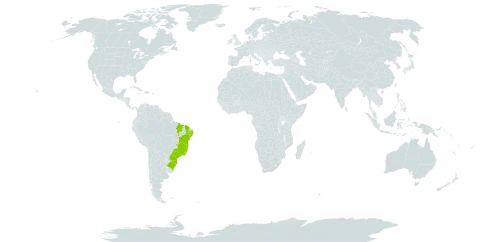Characteristics
A perennial hermaphrodite tree. It grows 10m high.
| Life form |
perennial
|
| Growth form |
tree
|
| Growth support |
free-standing
|
| Foliage retention |
|
| Sexuality |
hermaphrodite
|
| Pollination |
-
|
| Spread |
-
|
| Mature width (meter) |
-
|
| Mature height (meter) |
10.0
|
| Root system |
-
|
| Rooting depth (meter) |
-
|
| Root diameter (meter) |
-
|
| Flower color |
-
|
| Blooming months |
-
|
| Fruit color |
-
|
| Fruiting months |
-
|
| Nitrogen fixer |
-
|
| Photosynthetic pathway |
c3
|
Environment
Atlantic rainforest and semideciduous forest, growing i both dense primary forest and also in more open and secondary areas of growth, preferring well-drained clayey soils on slopes and hill tops.
| Light |
-
|
| Soil humidity |
-
|
| Soil texture |
-
|
| Soil acidity |
-
|
| Soil nutriment |
-
|
| Hardiness (USDA) |

|
Usage
Cultivation
Can be grown by seedlings.
| Mode |
seedlings
|
| Germination duration (days) |
-
|
| Germination temperacture (C°) |
-
|
| Germination luminosity |
-
|
| Germination treatment |
-
|
| Minimum temperature (C°) |
-
|
| Optimum temperature (C°) |
-
|
| Size |
-
|
| Vigor |
-
|
| Productivity |
-
|

